Installation of open wiring: a review of the technology of work + analysis of the main errors
Wiring is laid in two ways - closed and open. In the first case, communications are masked, and the likelihood of their damage is minimal. Installation of open wiring is simpler, cheaper, and less time consuming, but you have to protect the cables from moisture, mechanical damage.
In this article, we will consider the existing methods for laying electrical wires, focus on the features of external installation and give recommendations on how to choose the suitable option.
The content of the article:
What do electricians think about open wiring?
The disadvantages of open (external) wiring are much greater than that of hidden (internal).
Cables covered with plaster are not damaged, do not interfere with repair and are completely invisible. Open wiring is devoid of such advantages, and in the event of a short circuit it will light up more likely than hidden. An open installation method for wiring is often chosen for wooden houses.
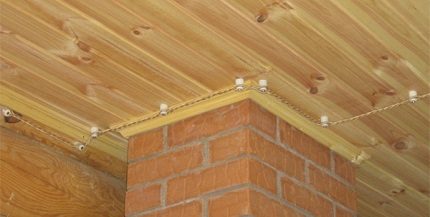
The open installation method still has some advantages:
- Simplified styling. When laying electric cables, you don’t have to ditch the walls. This reduces labor costs, the amount of work. After installation, almost no construction debris remains.
- Cheaper. Here we are talking about saving on paying for electricians.
- Possibility to change cable routing. If plans for the future include redevelopment of the wiring, then it is better to choose an open installation method.
When choosing an open method for laying electrical wires, it should be borne in mind that they will have to be masked and protected from external influences. There is always the possibility of moisture or accidental damage.
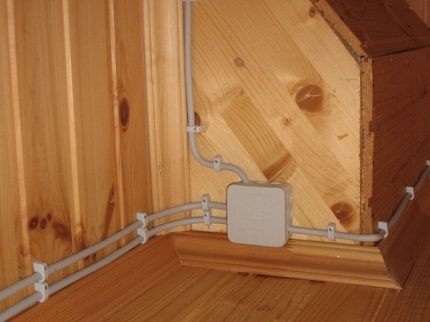
If the house is residential, you need to weigh everything three times. It is advisable to consult an experienced electrician, and during installation it is necessary to take into account the increased risks and especially carefully monitor compliance with safety measures.
Features of external laying of electric cables
External installation is suitable if you need to lay electrical cables in the corners of the room, at the junction of the ceiling and walls, along the baseboard.
Most often, difficulties arise when arranging open wiring in houses with suspended ceilings. Cables cannot be routed along such ceilings; you have to fix them on the walls.
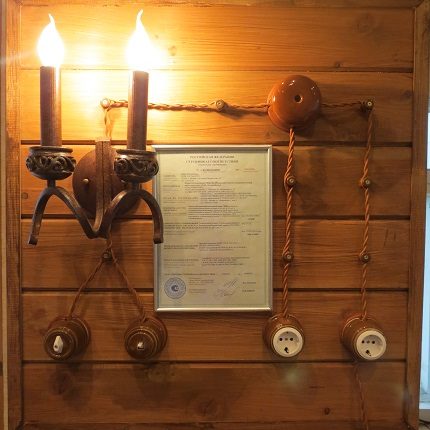
If there are a lot of wires, it is better to lay them in the through channels. When developing the installation scheme, you need to carefully select the places where the branch and connecting boxes. Free access should be maintained for inspections and possible repairs of communications.
Open wiring methods
Initially, the only open installation method was to lay twisted electrical wires along the walls and ceiling. They were mounted on ceramic insulators.
In some houses built about a century ago, wiring is still laid this way. Relatively recently, a similar installation has again gained popularity. This is due to the fashion of antiquity.
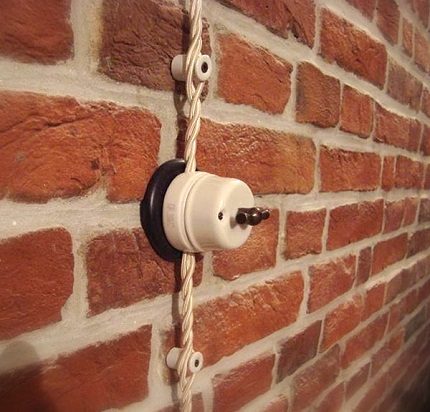
When designing rooms in retro style, there are often problems with finding materials. Some manufacturers produce ceramic insulators, sockets, antique switches, but such a luxury is very expensive.
Suitable materials for decorating retro-style wiring can be found not only in expensive stores. Often they are purchased from junk workers, bought from owners of houses built at the beginning of the last century, and cables are made independently by twisting stranded copper wires.
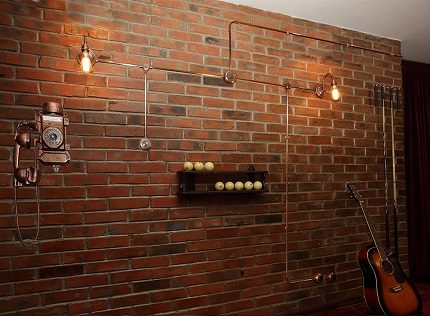
The interior fashion is changeable, so you should seriously consider whether you need to make wiring in retro style. It is better to choose a more popular and reliable option. Then, in case of repair, you will not have to do electrical work again.
We offer you to consider in detail the popular ways of laying open wiring and choose the technology that is most suitable for your home.
Method 1 - mounting wires on brackets
For connecting sockets and switches choose electric wires section 2.5 mm.kv., and for lighting devices - 1.5 mm.kv. Thicker cables are sometimes required.If the thickness of the wire is 1.5-6 mm.sq., they can simply be attached to the surfaces of walls and ceilings with brackets.
When buying cables, you should give preference to quality products. If the choice is made in favor of cheap wires, then non-combustible gaskets are mounted under them to reduce the risk of fire during a short circuit.
Their choice should be taken very carefully, because in future the functionality and safety of the home power grid will depend on them. We recommend to see information on how calculate wire cross section for home wiring.
The most commonly used bands are metal or asbestos. They are fixed so that the non-combustible gasket protrudes beyond the cable by at least 1 cm on each side. As for the material, it is better to choose metal, because asbestos is harmful to human health: its connection with cancer is proven.

Brackets are a cheap and easy way to install wiring. Of the minuses - it is unsafe and ugly. If several cables are laid, they are striking and spoil the impression of the interior. In a residential building, it is better to lay the wires in the cable channels.
Method 2 - features of laying in pipes
Modern industry produces special electrical pipes. They can be made of metal or plastic, well protect against fire, accidental mechanical damage and electric shock.
For installation, it is most convenient to use corrugated pipes. They are flexible, so that when mounting on walls, you do not have to additionally level the surfaces. Corrugated pipe wiring is ideal for wooden log homes. It is convenient and looks much neater than individual wires.
Due to the dubious aesthetics of the corrugation, it is rarely used in residential buildings, but it is perfect for connecting cables from overhead power lines. Sometimes, in order to improve the appearance of open wiring inside rooms, colored corrugated pipes are used.
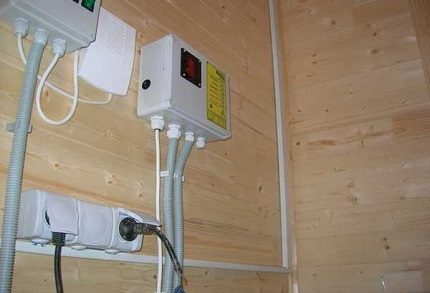
When calculating the diameter of the corrugation, they are guided by the total thickness of all the wires that will be laid in it. This figure is multiplied by 2, because with a smaller cross-section of the pipe it will be difficult to lay cables in it.
To facilitate laying, corrugated tubes with a special probe (a wire with which the cables are pulled) are used. Attach the wires to the probe and pull them through the pipe, holding it tightly in your hands.
If you need to lay a relatively small piece of wire, it is quite possible to do without a probe, but for large segments it is better to use special devices.
The wiring device in the polymer corrugation is made in the following order:
Corrugated electrical pipes are fixed to the walls with screws, dowels, nails or plastic clips. The distance between the attachment points is calculated depending on the diameter and, accordingly, the estimated weight. If the diameter of the corrugated pipe is 16 mm, then the fasteners are placed at a distance of 30–40 cm, and for pipes 32–40 mm this distance is already less than 20–30 cm.

The clips are mounted on the walls, and then simply insert a corrugated pipe into them. This method of fastening is convenient in that when disassembling it is enough to pull the pipe toward you and the clips will easily detach.
Method 3 - laying in boxes
Rigid electrical ducts are used for laying wires cable channelsskirting board. These devices are made of metal or non-combustible plastic. Unlike corrugated pipes, rigid structures cannot be installed on uneven walls, as surface defects only become more visible.
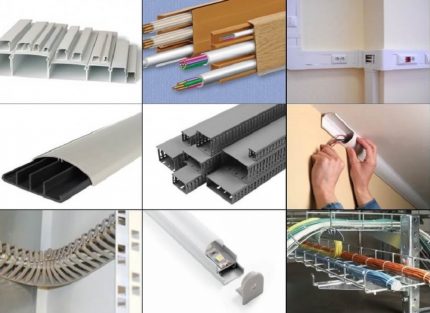
Boxes, channels, skirting boards are equipped with snap-on covers that can be easily removed, which is convenient for mounting additional wires. If you need to upgrade the wiring, the whole process will take several minutes.
There are other pluses:
- Design. Boxes, cable channels and skirting boards are available in different colors, which allows you to decorate the room. You can always choose the right option.
- Easy installation. Laying cables in boxes does not require much effort. The main thing is to properly secure the protective structures themselves.
- Convenient installation of sockets and switches. Outlets can be mounted on the box, and they will not spoil the overall look.
Installation work begins with the preparation of a drawing diagram with a scan of the walls. It is needed for the accurate calculation of the necessary materials, the number of fasteners, accessories.
To select a channel by size, you must first determine the cross-section and the number of cables. The finished plan must be accurate, without errors in measurements and calculations.
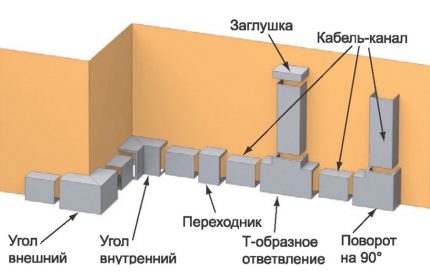
Technology for mounting external wiring in cable channels:
- Project drafting. It is necessary to determine the number, types and location of sockets, switches, boxes and think over cable routing bypassing gas and water pipes, sewer systems.
- Selection of materials. After designing, you can proceed to the selection and purchase of materials. If you plan to lay several cables, you should choose a box with partitions. Accessories must match the channel in color and size. It makes sense to buy protective boxes with devices for installing outlets.
- Box fixing. Plastic structures can crack if they are immediately attached to the wall, so first make holes in the cases of the boxes, and only then screw them to the base. Cable channels are joined together, and excess material is cut off.
- Wiring. Cables are laid in the housing of the channels, closed with covers and snap them. It remains only to check the fixation of the covers - and the design is ready.
Electricians advise paying attention to the base material, as the choice of fasteners depends on this. So, on the wooden wall of the box is attached using ordinary screws. For brick, concrete and stone surfaces, dowels are used. And for panels, plates made of composite materials and plywood, it is better to choose butterfly fasteners.
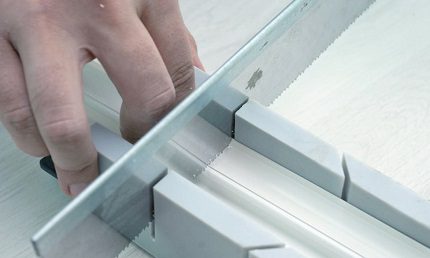
Each installation method has its own advantages, and it rarely happens that one method is enough. Often it is necessary to combine cable channels with corrugated and / or metal pipes, fasteners on brackets.
The construction of electrical wiring using cable channels includes a number of standard steps:
When developing a wiring project, you should take into account the layout of the room and the features of the cabling in each of the sections - whether it is a bedroom, kitchen or bathroom.
10 common mistakes electricians
An open way of laying electric cables is easier than a closed one, but still there are nuances that cannot be taken into account until there is a certain practice.
We offer an overview of typical mistakes made during wiring:
- Lack of circuit. Often, wiring is mounted according to the principle of the designer: first they make wiring in each room, and then the cables are combined. This dramatically reduces the reliability of the entire system.
- Material savings. Low-quality wires, devices and accessories are a direct and short way to a fire. It is better to overpay for products of a reliable brand than to solve problems with short circuits and fires.
- Calculation of posting without stock. The cross-section of the cables and their number should be 20% more than the calculated. Otherwise, unnecessary twists and the risk that the network will not withstand the load cannot be avoided.
- Connecting powerful appliances through a power outletinstead of using a separate cable from the shield. Even a power outlet does not solve this problem, because There is always a risk that the cable will not cope with a serious additional load.
- Connection of high and low voltage cables in one box. In this case, problems with the operation of equipment throughout the house are almost guaranteed.
- Extra twists. To connect the wires, it is better to use special terminals.
- Connection of cores from copper and aluminum. Contact points overheat, which can lead to problems. For the connection, it is worth using terminals, but it is better to avoid aluminum wires and lay only copper ones.
- Neglect of safety. The rules of TB are written on the basis of the bitter experience of many unsuccessful electricians, and still there are still daredevils working under voltage.
- Incorrect junction box layout. They should be 20 cm below the ceiling. Otherwise, there is a risk of accidental damage. Boxes must be accessible for inspection and repair.
- Errors in installing the ground loop and connecting an RCD. These devices protect the mains, so their installation should be treated with particular care.
Novice electricians make other mistakes. We have listed only the most common.
It is important to remember that the installation of electrical wiring is fraught with many risks, so before starting work, you should carefully study the technology.
Conclusions and useful video on the topic
We picked up useful video materials that will help to avoid frequent installation errors and properly organize external wiring in the house.
Installation instructions for wiring in the cable channel:
Useful tips for installing outlets:
The main mistakes that are made when connecting an RCD:
In theory, the technology for arranging open wiring looks simple and straightforward. But when it comes to practice, many homeowners make a lot of mistakes.
Take on an independent installation only if you have the necessary knowledge for the development and implementation of the project. If not, don’t risk your life and entrust this work to electricians..
Are you well versed in the theory of open wiring and have practical experience in performing electrical work? Maybe you want to supplement our material with clarifications or useful recommendations? Write comments in the block under the article, share your experience with beginners - many users will be grateful to you.

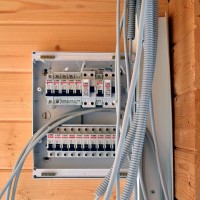 Wiring in the apartment: an overview of the main schemes and the procedure for performing work
Wiring in the apartment: an overview of the main schemes and the procedure for performing work 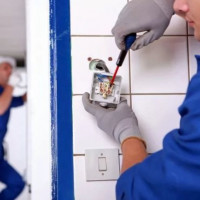 DIY wiring: how to properly perform electrical work
DIY wiring: how to properly perform electrical work  Corrugation for electrical wiring: how to choose and install a corrugated sleeve for cable
Corrugation for electrical wiring: how to choose and install a corrugated sleeve for cable 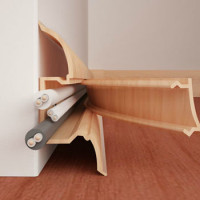 Cable channel for electrical wiring: types of structures and their classification
Cable channel for electrical wiring: types of structures and their classification 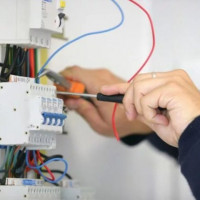 Wiring diagram in the apartment: electrical wiring for different rooms
Wiring diagram in the apartment: electrical wiring for different rooms 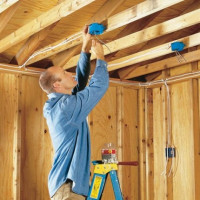 Wiring in a wooden house: design rules + step-by-step installation
Wiring in a wooden house: design rules + step-by-step installation  How much does it cost to connect gas to a private house: the price of organizing gas supply
How much does it cost to connect gas to a private house: the price of organizing gas supply  The best washing machines with dryer: model rating and customer tips
The best washing machines with dryer: model rating and customer tips  What is the color temperature of light and the nuances of choosing the temperature of the lamps to suit your needs
What is the color temperature of light and the nuances of choosing the temperature of the lamps to suit your needs  Replacement of a geyser in an apartment: replacement paperwork + basic norms and requirements
Replacement of a geyser in an apartment: replacement paperwork + basic norms and requirements
I made a mistake at the time, I confess, I decided not to change the wiring from the previous owners during the repair. Now I know for sure that unreliable floors, wiring and sewerage are the first items to check and replace. An urgent problem was the presence of additional outlets in the kitchen and a power line for an exhaust fan. I plan to supplement the existing wiring diagram with the installation of a cable from a box in the corridor to the kitchen in an open way.
I want to hide section 2.5 in a small plastic protective box that will be mounted at the corner of the junction of the ceiling and the wall, I think I’ll cover the box with a ceiling plinth. The descent to the outlets can be done by making a channel in the tiled coating of one of the kitchen walls with further sealing. In my opinion, this is the easiest and safest way to install in the presence of a ready-made repair. Installation through the floor skirting I do not consider because of the risk of moisture.
They write that open wiring is more at risk of fire. But, when the wiring is closed in the wall in case of fire, its specific place is not visible, and you can break a half-wall until you find damage. I had such a case. Now only open wiring to quickly replace if something happens. I will mount in the boxes, of course, not myself. Yes, there will be difficulties during repairs, etc., but all these problems can be solved - I want all the wiring to be in front of our eyes and to make it easy to get to everything.
I needed to install an additional outlet. I connected the wiring to it to an existing outlet, lowered it to the plinth in the stub, then laid it openly along the plinth.
What are the benefits of open wiring? For this you need some special permissions, should there also be special wires?